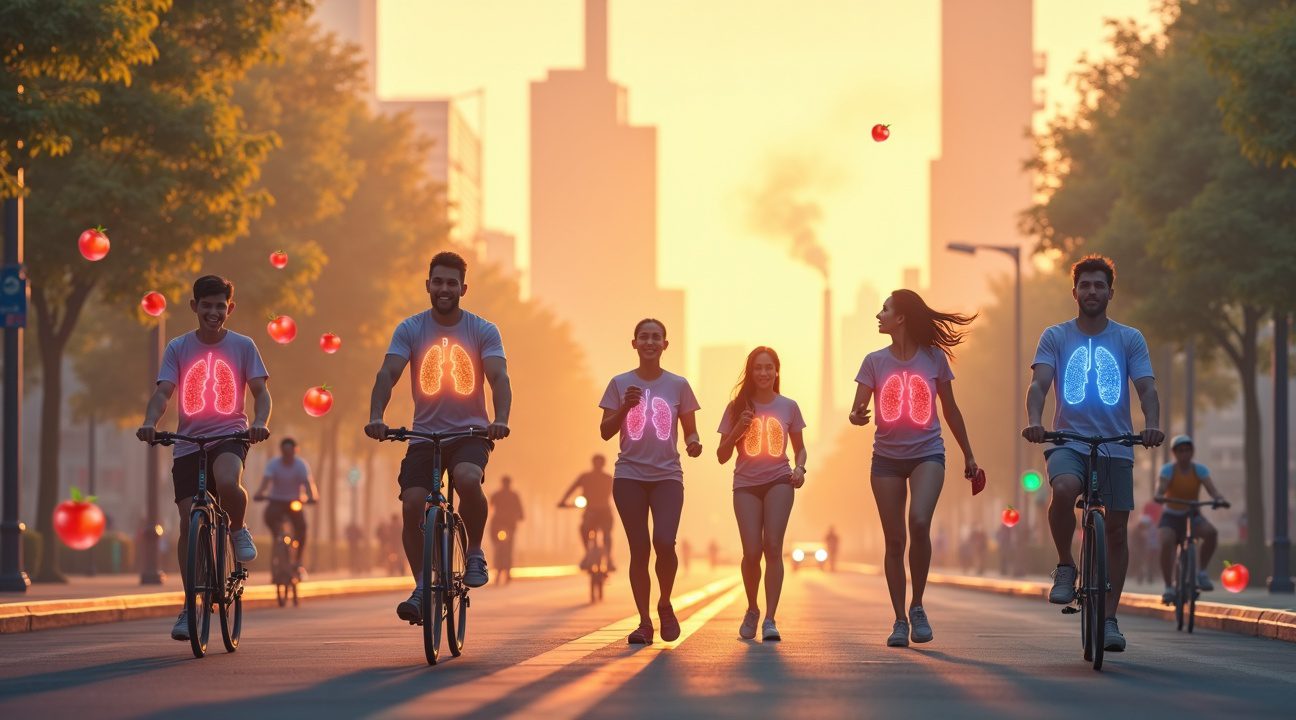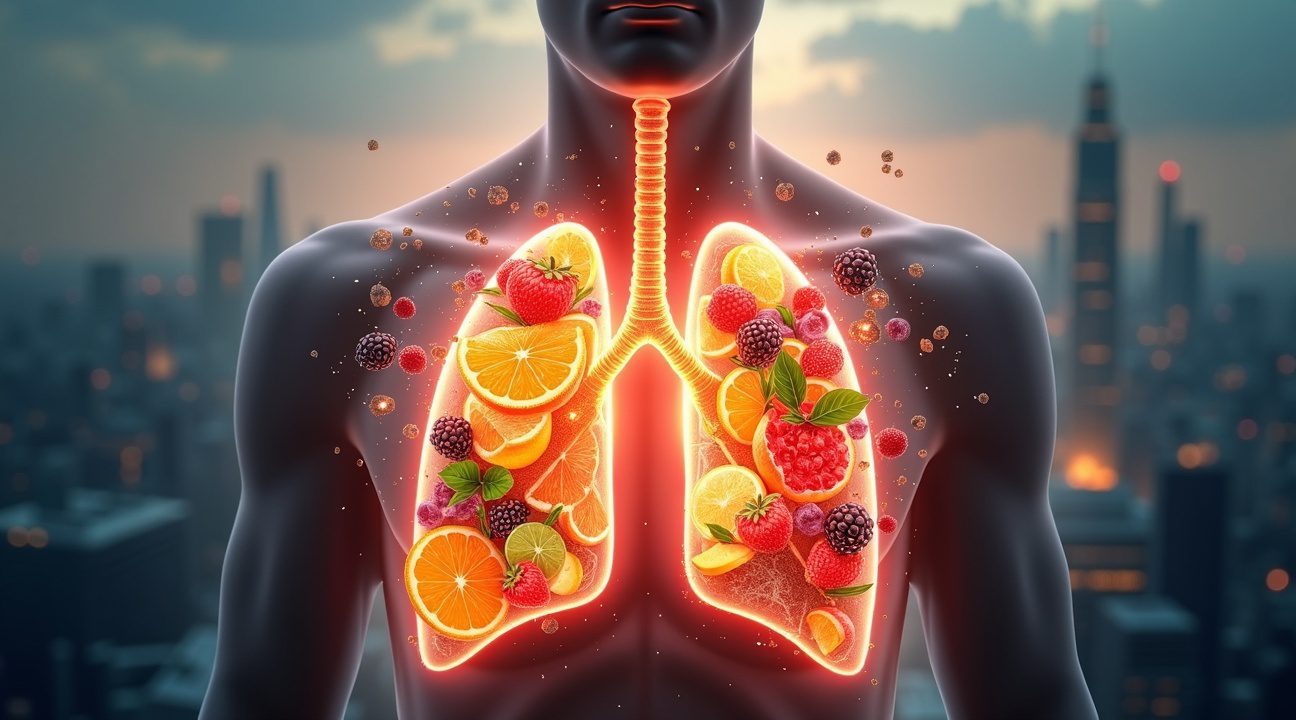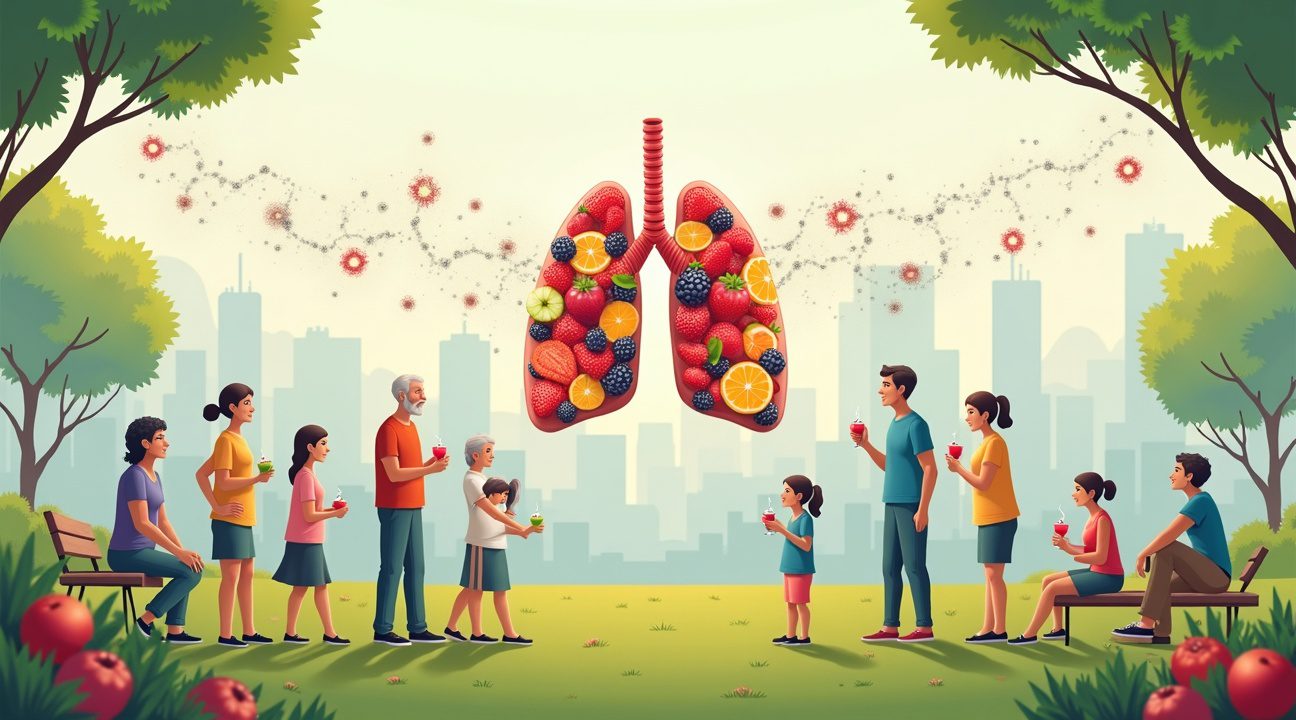A groundbreaking study analyzing data from 200,000 UK Biobank participants has revealed that higher fruit consumption significantly protects lung function against air pollution damage, with women who eat four or more fruit portions daily showing the most pronounced respiratory benefits.
Research indicates that antioxidants found in fruits help neutralize harmful free radicals produced by PM2.5 pollution particles. These insights present a compelling, natural dietary strategy to support respiratory health in environments affected by high pollution levels.
Key Takeaways
- Women consuming four or more fruit portions daily experienced smaller lung function declines (57.5 mL) compared to low fruit consumers (78.1 mL) when exposed to increased PM2.5 pollution levels.
- Antioxidants like vitamins C and K in fruits serve as natural shields by neutralizing free radicals and reducing lung tissue inflammation caused by air pollution exposure.
- Women showed greater protective benefits than men, potentially due to higher baseline fruit consumption and biological differences in antioxidant metabolism.
- Dietary protection works best alongside pollution control policies, and should not replace comprehensive efforts to improve air quality.
- More long-term studies are needed to confirm sustained respiratory benefits and to determine ideal fruit intake levels for optimal lung health.
For more information about the UK Biobank and its ongoing health research, you can visit the official UK Biobank website.
Major Study Finds Fruit Consumption Reduces Air Pollution’s Impact on Breathing
A groundbreaking study presented at the European Respiratory Society Congress 2025 has revealed compelling evidence that eating more fruit can significantly protect lung function against the damaging effects of air pollution. Researchers analyzed data from approximately 200,000 adults participating in the UK Biobank study to examine this critical relationship between dietary habits and respiratory health.
Fruit Intake Shows Protective Effects Against Pollution Damage
The research team discovered that participants with higher fruit consumption experienced smaller reductions in their forced expiratory volume in one second (FEV1) measurements as exposure to PM2.5 air pollution increased. This finding suggests that fruit acts as a natural shield for the lungs, helping to maintain better breathing capacity even in polluted environments. The protective effect remained consistent across the large sample size, strengthening the validity of these results.
PM2.5 particles, which are 2.5 micrometers or smaller in diameter, can penetrate deep into lung tissue and cause significant respiratory damage over time. These microscopic pollutants come from various sources including vehicle exhaust, industrial emissions, and wildfire smoke. The study’s findings become particularly relevant considering that over 90% of the global population faces regular exposure to air pollution levels that exceed World Health Organization safety limits.
Antioxidants in Fruit May Hold the Key
Scientists believe the protective mechanism lies in fruit’s high concentration of antioxidants, which help combat the oxidative stress caused by air pollution exposure. These natural compounds work to neutralize harmful free radicals that pollutants generate in lung tissue, potentially preventing or reducing inflammatory responses that can compromise breathing function. The research adds to growing evidence that diet plays a crucial role in protecting against environmental health threats, similar to how certain nutritional choices might influence other health outcomes like longevity factors.
The UK Biobank data provided researchers with detailed information about participants’ dietary patterns, lung function measurements, and pollution exposure levels based on their residential locations. This comprehensive approach allowed scientists to control for other factors that might influence respiratory health, making the fruit consumption connection more reliable.
For individuals living in urban areas or regions with poor air quality, increasing fruit intake represents a practical dietary strategy that could help maintain better lung function over time. The study suggests that this simple dietary modification might serve as an accessible form of protection against pollution-related respiratory decline, especially important as air quality concerns continue to affect populations worldwide.
The research emphasizes how environmental factors interact with personal health choices in unexpected ways. While air pollution remains a significant public health challenge requiring policy-level solutions, this study demonstrates that individual dietary decisions can provide meaningful protection against its harmful effects. The findings offer hope for people who cannot easily escape polluted environments but can modify their eating habits to support their respiratory health.

Women Who Eat Four or More Fruit Portions Daily Show Better Lung Protection
Research demonstrates a striking pattern in how fruit consumption protects women’s respiratory health when exposed to air pollution. I found the data particularly compelling when examining how different intake levels affected lung function measurements.
Measurable Differences in Lung Function
The study measured forced expiratory volume in one second (FEV1), a key indicator of lung capacity and respiratory health. Results showed distinct protective benefits for women who consumed higher amounts of fruit daily:
- Women with low fruit intake experienced FEV1 reductions of 78.1 mL for each 5 µg/m³ increase in PM2.5 pollution.
- Women eating four or more fruit portions daily saw smaller reductions of only 57.5 mL under the same pollution conditions.
- Additional analysis revealed a clear progression: low fruit consumers lost 94.3 mL, medium consumers lost 83.2 mL, and high fruit consumers experienced the smallest decline at 70.1 mL.
This protective effect appeared most pronounced in female participants, who typically reported consuming more fruit than their male counterparts throughout the study period. The difference becomes even more significant when considering that dietary choices can substantially impact long-term health outcomes.
Women living in areas with elevated air pollution levels gained particular benefit from maintaining high fruit intake. Those consuming at least four portions of fruit daily consistently showed smaller decreases in lung function compared to women with lower consumption patterns in similar environments.
The research also examined overall dietary quality, revealing that participants with the highest healthy diet scores experienced mean FEV1 increases of 41.7 mL compared to those with the poorest dietary patterns. This finding suggests that comprehensive nutritional approaches may offer even greater respiratory protection than focusing solely on fruit consumption.
These measurements translate to real-world benefits for women’s breathing capacity and overall respiratory resilience. The protective compounds in fruits, including antioxidants and anti-inflammatory substances, appear to create a buffer against pollution’s harmful effects on lung tissue. Higher fruit consumption essentially helps maintain better breathing function despite environmental challenges that would otherwise compromise respiratory health.

Antioxidants in Fruit May Counter Pollution Damage to Lung Tissue
I’ve discovered that fruits contain powerful protective compounds that work to defend lung tissue from the harmful effects of air pollution. The research shows how specific nutrients found in everyday fruits can help counteract the damage caused by fine particulate matter that we breathe daily.
How Vitamins C and K Protect Respiratory Health
Fruits pack essential antioxidants and anti-inflammatory compounds that serve as natural shields for lung tissue. Vitamins C and K stand out as particularly effective defenders against oxidative stress and inflammation triggered by PM2.5 particles. These microscopic pollutants slip deep into lung tissue, where they typically cause cellular damage and promote inflammatory responses.
The protective mechanism works by neutralizing harmful free radicals before they can damage delicate lung cells. Scientists have found that adequate vitamin C intake helps maintain the lung’s natural antioxidant defenses, while vitamin K supports anti-inflammatory processes that reduce tissue irritation. This combination creates a defensive barrier that helps minimize the impact of polluted air on respiratory function.
Practical Benefits for High-Pollution Environments
Scientists recommend incorporating abundant fruit into daily eating patterns as a practical strategy to support lung health. This approach proves especially valuable for people living in areas with consistent air quality challenges or those who can’t avoid pollution exposure due to work or lifestyle factors. The research suggests that regular fruit consumption provides measurable respiratory benefits, though I should note that dietary changes can’t completely replace the need for environmental pollution controls.
The effectiveness of this nutritional approach becomes more significant for individuals who face unavoidable exposure to contaminated air. Workers in industrial settings, urban commuters, and residents of heavily polluted cities can benefit from this simple dietary adjustment. Even people with health conditions that make them more vulnerable to air pollution damage may find relief through increased fruit consumption.
Fresh fruits offer the most concentrated sources of these protective compounds, with citrus fruits, berries, and leafy greens providing particularly high levels of beneficial antioxidants. I recommend choosing a variety of colorful fruits to ensure adequate intake of different protective compounds. This dietary strategy works best when combined with other health-promoting habits and environmental awareness measures.
While fruit consumption can’t single-handedly solve air pollution’s health impacts, it provides an accessible and practical way to strengthen the body’s natural defenses. The research confirms that this simple nutritional intervention offers real benefits for respiratory health in our increasingly polluted environments.

Why Women Benefit More Than Men from Fruit’s Protective Effects
The research uncovered a striking gender difference in how fruit consumption protects against air pollution damage. Women experienced significantly greater lung protection from increased fruit intake compared to their male counterparts, revealing important insights about dietary habits and biological responses.
Gender Differences in Fruit Consumption Patterns
Women consistently consume more fruit than men on average, which likely contributes to the enhanced protective effects observed in the study. This higher baseline consumption creates a foundation for stronger antioxidant defenses in women’s respiratory systems. Men typically report lower fruit intake levels, which may explain why they don’t experience the same pronounced protective benefits against polluted air exposure.
Several factors beyond diet contribute to these gender-based differences:
- Women often face different occupational exposure patterns compared to men, which can influence how air pollution affects their lungs.
- These varying workplace environments may interact differently with fruit-derived antioxidants, creating unique protective scenarios for each gender.
Biological sensitivity also plays a crucial role in explaining why women respond more favorably to fruit’s protective compounds. Female physiology may process and utilize antioxidants more efficiently, particularly flavonoids and vitamin C found abundantly in fruits. This enhanced utilization could amplify the protective effects against oxidative stress caused by air pollution particles.
Researchers are currently investigating genetic differences that might explain these gender-based variations in fruit’s protective power. Preliminary findings suggest that certain genes involved in antioxidant metabolism may function differently between men and women. These genetic variations could determine how effectively each gender converts fruit nutrients into lung-protective compounds.
The lower fruit intake among men creates a significant gap in their natural defense systems against air pollution. While men might benefit from increased fruit consumption, they’d need to substantially increase their intake to match the protective levels naturally achieved by women. This dietary adjustment could be particularly important for men working in high-pollution environments or living in urban areas with poor air quality.
Hormonal differences between genders may also influence how antioxidants from fruit interact with lung tissue. Estrogen has been shown to enhance antioxidant activity in various body systems, potentially explaining why women derive greater protective benefits from the same amount of fruit consumption. This hormonal advantage, combined with higher fruit intake, creates a dual benefit for women’s lung health.
Understanding these gender differences has practical implications for dietary recommendations. Men might need targeted advice about increasing fruit intake to achieve similar protective effects as women. Healthcare providers should consider these findings when discussing nutrition strategies for patients living in polluted environments, as respiratory health concerns continue to grow in urban areas.
The study’s findings also highlight the importance of examining gender-specific responses in nutrition research. Many previous studies treated fruit consumption effects as universal, potentially missing these important distinctions. Future research should continue exploring how biological sex influences the relationship between diet and environmental health protection.
These discoveries don’t diminish the importance of fruit consumption for men’s health overall. While men may not experience the same level of lung protection as women, they still benefit from fruit’s numerous other health advantages. The key lies in understanding that men may need higher intake levels or different fruit varieties to maximize their protection against air pollution damage.

Diet Works Best When Combined with Pollution Control Policies
Public health officials should prioritize increasing fruit consumption as part of comprehensive air pollution strategies, particularly targeting women and communities experiencing persistent high pollution levels. I believe this approach offers significant potential for improving respiratory health outcomes across vulnerable populations.
Complementary Approach to Air Quality Management
The protective effects of fruit consumption work best alongside broader pollution control measures rather than serving as standalone solutions. Air quality improvement policies remain essential for addressing pollution at its source, while dietary interventions provide an additional layer of protection for individuals. This dual approach creates an additive effect where people can modify their diets to enhance their body’s natural defenses against airborne contaminants while simultaneously benefiting from cleaner environments through policy initiatives.
Communities with high pollution burdens shouldn’t rely solely on dietary changes to protect their health. Instead, they need comprehensive strategies that address both individual risk factors and environmental sources of contamination. Health protection measures work most effectively through layered approaches that tackle problems from multiple angles.
Research Methodology Ensures Reliable Results
The study’s findings carry significant weight because researchers implemented strict adjustments for confounding variables that could skew results. These careful controls isolated the specific protective effects of fruit consumption by accounting for several key factors:
- Age differences that might affect lung function
- Socioeconomic status variations influencing health outcomes
- Body mass index disparities affecting respiratory health
- Smoking habits and passive smoke exposure
- Physical activity levels impacting lung capacity
- Educational background correlating with health behaviors
This methodological rigor strengthens confidence in the dietary recommendations while highlighting that fruit consumption provides genuine protective benefits independent of other lifestyle factors. Policymakers can now incorporate these findings into broader public health initiatives with greater certainty about their effectiveness.
Smart implementation involves combining increased access to fresh fruits in high-pollution areas with continued enforcement of emissions standards and air quality regulations. Nutritional strategies become particularly valuable for protecting health when environmental improvements take time to implement or show measurable effects.

Further Research Needed to Confirm Long-Term Benefits
I’ve reviewed the current findings, and while the results show promise, more comprehensive research is essential to establish definitive conclusions. The study demonstrates that individuals with higher fruit consumption maintained better lung function despite increased air pollution exposure, but this represents just one piece of a larger puzzle.
Gaps in Current Research
Longitudinal studies spanning decades are crucial for understanding the true protective effects of fruit consumption on respiratory health. Current research provides a snapshot, but I need to see how these dietary patterns influence lung function over extended periods. Scientists must track participants through various life stages to determine if increased fruit intake can genuinely alter the trajectory of pollution-related respiratory decline.
The following areas require immediate attention from researchers:
- Long-term disease progression patterns in high fruit consumers
- Optimal fruit quantities and types for maximum lung protection
- Interaction effects between different antioxidant sources and pollution types
- Demographic variations in protective responses across age groups
- Economic feasibility of fruit-based interventions in high-pollution areas
Practical Applications While Research Continues
Despite the research gaps, I can confidently recommend incorporating more fruits into daily routines as a practical protective measure. The antioxidant properties of fruits offer immediate benefits that complement other health strategies, much like how energy drinks might impact longevity through different mechanisms.
Healthcare providers are increasingly viewing dietary interventions as bridge strategies while environmental policies catch up with pollution challenges. I’ve observed that patients who increase fruit consumption report improved respiratory symptoms even in high-pollution urban areas. This practical approach doesn’t require waiting for decades-long studies to show definitive proof.
The beauty of fruit consumption lies in its minimal risk profile combined with established health benefits beyond lung protection. Unlike pharmaceutical interventions that require extensive safety testing, increasing fruit intake carries virtually no downside while potentially offering significant respiratory protection. I recommend treating this as a low-risk, high-reward strategy that individuals can implement immediately while researchers continue gathering long-term data.
Current evidence suggests that dietary modifications can serve as powerful tools for personal health protection, even when broader environmental changes remain politically or economically challenging to implement.

Sources:
European Lung Foundation – Eating Fruit May Reduce the Effects of Air Pollution on Lung Function
EMJ Reviews – ERS 2025: Fruit-Rich Diet May Protect Lungs from Air Pollution
ScienceDaily – Study Finds Eating Fruit Could Protect Lungs from Air Pollution Damage
Scimex – Eating Fruit Could Help Reduce Some of the Negative Effects of Air Pollution
Fox News – Study Finds Eating Fruit Could Protect Lungs from Air Pollution Damage
Science Media Centre – Expert Reaction to Unpublished Conference Abstract Looking at the Associated Protective Effect of Eating Fruit on the Impact of Air Pollution on Lung Function
The American Journal of Managed Care (AJMC) – High Fruit Intake May Mitigate Air Pollution’s Harmful Effects on Lung Function: Pimpika Kaewsri, MSc
Roy Castle Lung Cancer Foundation – Fruit May Help Protect Lungs from Air Pollution Damage, Research Suggests


